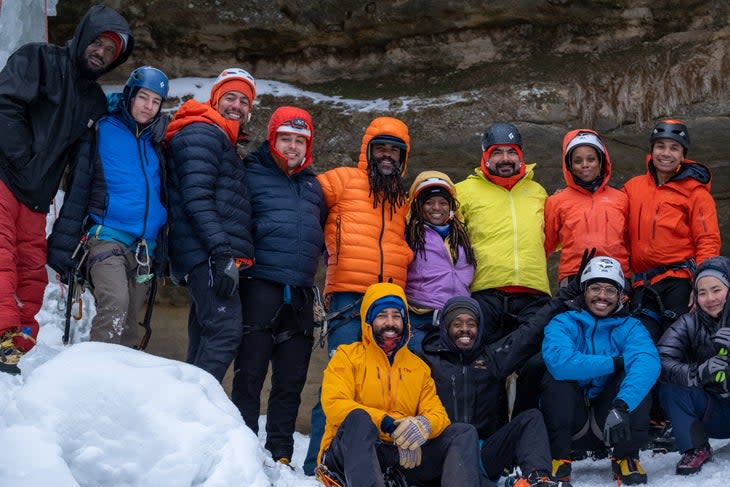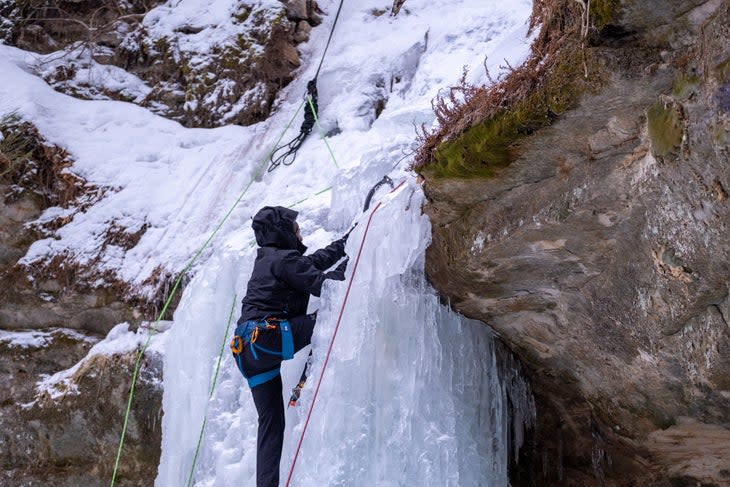AAC’s BIPOC Ice Climbing Scholarship Winner Talks Access
This article originally appeared on Climbing
Out of all the climbing disciplines, ice might put up the biggest barrier to entry. Access to the highly specific gear, the terrain, and mentorship opportunities aren't easy to come by. Getting started often requires good connections and even better finances.
That's part of the reason why Xavier Abdullahi applied for the BIPOC Ice Climbing Scholarship from the Twin Cities Chapter of the American Alpine Club. He wanted the chance to explore a new side of climbing that might otherwise have remained out of reach. The scholarship provides both a full outfit of gear from Arc'teryx, Petzl, and Scarpa as well as two full days of guided instruction on the ice.

Access issues aside, there's a good reason why ice climbing bears such a reputation for exclusivity: it's difficult, dangerous, and often unpredictable--much more so than climbing on rock. Fickle conditions leave little room for error or poor judgment. Winging it won't work here.
So for beginner ice climbers, context is key; your surroundings matter--not just where you are, but who you're with. Safety depends on clear lines of communication. Climbers need to feel comfortable speaking their minds to avoid careless mistakes. The silence that comes from social unease is a fast track to getting in over your head.
Abdullahi knew this when he decided to go for the scholarship. BIPOC meetups put on by his local AAC chapter had helped introduce him to climbing in the first place. He understood the power of tackling challenges with like-minded people by his side, peers who could relate without hesitation or explanation. This is the way that Abdullahi wanted to navigate ice climbing for the first time. When he won, his excitement came from knowing that he was getting more than just the opportunity to pick up an exciting new skill set--he would get to climb freely without the weight of worrying about what others saw in him or how he came across. Talk about a low gravity day.

That's exactly how it played out for the group that showed up to the Intro to Ice for People of Color clinic at the No Boundaries Waterfall during the Michigan Ice Fest. The day flowed so naturally that Abdullahi had trouble explaining exactly why. It was more the absence of anything noteworthy that made the clinic successful. "I could focus on just being there," Abdullahi reflects. "Everyone understood me and my background. I didn't ever have to prove myself."
The freedom to just be left them all with enough energy to learn. More than enough, in fact. What started as a simple intro course took a turn as the group quickly got the hang of things. Instructors Dom Mullins, part of the Full Circle Everest Team, and Rodel Querubin, the BIPOC Initiatives Chair for the Twin Cities Chapter of the AAC, led them through proper ice picking technique, balanced movement drills, basic anchoring and building V-threads, ice screwing, and--of course--how to perform the classic "figure 4". The session was supposed to end at 3 that afternoon; instead, they stayed out until past 5 before anyone noticed the time. "We all just wanted one more go!" laughs Abdullahi. "I don't remember feeling the least bit cold or tired."
Even as the sun began to set, no one wanted to part ways just yet. They stopped for burgers on the drive back to help slow down the clock while hearing about Mullins' recent summit of Denali, and stuck together for a talk he was giving to festival goers that evening. By the end of the talk, they still weren't done with each other--so it was back to the frozen falls they went for a night climbing session under the nearly full moon. "It was beautiful," Abdullahi gushes. "The snow and ice were shining in the light of our headlamps. I felt like I just couldn't get enough--of the scenery or the people around me."
For the first time in who knows how long, Abdullahi had spent all of his waking hours with people of color. And in a climbing setting, no less. But the best part for Abdullahi was the fact that he only realized it later.
"Nothing out of the ordinary until we went to Dom's presentation, which was the first time I saw white people all day," he points out. "Most of the time, the only place that happens for me is in my own house."

It was only when he showed up for the second day of clinics that Abdullahi really noticed the difference. This time, he was the only black climber in the group. There was also only one woman present, and she was the instructor. Abdullahi immediately picked up on a reservedness that hadn't been there yesterday.
"On the first day, we were all comfortable right out the gate before we even got off the shuttle. On the second, it was quieter. We rode quietly, we hiked quietly, we just didn't automatically relate to each other. It was more small talk than really getting to know everyone. I did end up breaking the ice with a few people, but it took until the very end to feel comfortable doing so."
This clinic, Introduction to Leading on Ice, was technically supposed to be more advanced than the Intro to Ice course. But Abdullahi found that he'd actually learned significantly more on the first day than the second. He chalks that up to the natural connection they all had, which freed up so much mental space that they were able to absorb more knowledge.
Abdullahi fell in love with the ice that first day. But he wonders what might have happened if the days had been reversed.
"I would probably have walked away with less knowledge and understanding," he ponders. "I might have done things that weren't safe for me yet because I wasn't comfortable speaking up. I might have continued to believe what we've all grown up believing, that these were activities for white people and not us. But listening to Dom talk about how he showed up in Timberlands and jeans for his first time on the ice, we realized that he, this person who submitted Everest, had also never been able to see the stars at night as a kid. He had the same upbringing as us and he literally made history. Having that be the first thing I heard was...everything."
Thanks to the AAC's BIPOC Ice Climbing Scholarship, Michigan's frozen falls have earned themselves another worthy admirer. But it probably wouldn't have happened in any other context. When asked how the climbing community can create more of these opportunities for marginalized climbers to expand their horizons, Abdullahi emphasizes a combination of resources and camaraderie.
"The scholarship gave me both a learning experience and the opportunity to have more of those experiences in the future. It wasn't just a one time thing. Someone invested in the gear for me as well as a new community of people to climb with. I have incredible memories and the tools to keep going. The experience got me hooked. With the gear, I can then help change the status quo for good."
Abdullahi's all-encompassing experience on the ice shouldn't be unique. I shouldn't have had to ask him what made a course directed toward beginner BIPOC ice climbers so special, if the material was changed somehow or the lesson presented differently. In hindsight, part of me wishes I hadn't. I know I don't like having to explain why I thrive on climbing with other women who understand the fear--both rational and utterly existential--that can creep up without warning above the bolt. Trying to put words to that feeling of unquestionable fellowship almost ruins the magic. It's hard to share it with anyone on the outside. But I'm grateful to Xavier Abdullahi for sharing a bit of the magic he experienced at the Michigan Ice Fest with me. The biggest takeaway for event organizers: keep it up. This is a good start, but nowhere near the end. Give the climbing community more where this came from.
Also Read
After Nearly Dying From Cancer, She Rediscovered Her Strength Through Climbing
What I Learned Watching Will Bosi's Livestream of Burden of Dreams
For exclusive access to all of our fitness, gear, adventure, and travel stories, plus discounts on trips, events, and gear, sign up for Outside+ today.

